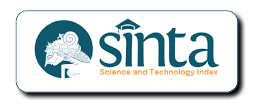HOW TO TEACHING THE EARLY READING TO MENTALLY DISABLE STUDENTS IN ELEMENTARY SCHOOL?
Abstract
Children with mentally disable is a children who has cognitive barriers experience, in early reading it is often disturbed by the difficulty of remembering the letters, and also connecting phonemes with the objects. This article presents innovations on how to teach early reading to mentally disable students in elementary schools. The purpose of this study is to provide an overview of how teachers teach early reading to mentally retarded students in elementary schools. This study uses qualitative methods that describe how teachers teach early reading, with the subject of mentally disable classroom teachers at SDLB Kasih Ibu Pekanbaru. Data collection techniques are through observation and interviews. The results of research observation planning data, the teacher gives emphasis to the letters and shows the image in accordance with the initial letter given emphasis, and linking the material with everyday life that can be found by students using an easy to understand reading method. Observation data of the presentation component, the teacher in explaining the material using simple language, by verbal media and giving emphasis to the letters that students’ will be read. The conclusion of this study is the application of one component of the skills explains in teaching initial reading, the component of material presentation in the first day's observations has been going well.
Keywords
Full Text:
PDFReferences
Angelka, K., & Goran, A. (2018). Learning Problems In Children With Mild Intellectual Disability. (IJCRSEE) International Journal of Cognitive Research in Science, Engineering and Education, 6(1), 31- 38. doi:10.5937/ijcrsee1801031K.
Alsamiri, Y. (2018). How Learning Disabilities Teachers In The Kingdom Of Saudi Arabia Define Students With Giftedness And Learning Disabilities. Cakrawala Pendidikan, XXXVII(3), 356- 365.
Adeleke, A. G. (2018). Teachers’ Familiarity and Opinion on Utilization of Narrative Recollection Technique in Basic Schools in Nigeria. International Journal Of Innovative Research & Development, 7(12), 37- 42. DOI No. : 10.24940/ijird/2018/v7/i12/OCT18028.
Burn, P. C., Betty, D., & Ross, E. P. (1996). Teaching Reading in Today’s Elementary School. Chicago: Rand Mc. Nally College Publishing Company.
Balboni, G., and L. Pedrabissi. 2000. “Attitudes of Italian Teachers and Parents towards School Inclusion of Students with Mental Retardation: The Role of Experience.” Education and Training in Mental Retardation and Developmental Disabilities, 35 (2), 148–159. http://www.jstor.org/stable/23879939.
Barcelos, A. M. F. (2015). Unveiling the relationship between language learning beliefs, emotions, and identities. Studies in Second Language Learning and Teaching, 5(2), 301-325. doi: 10.14746/ssllt.2015.5.2.6.
Beco, G. D. (2016). Transition to Inclusive Education Systems According to the Convention on the Rights of Persons with Disabilities. Nordic Journal Of Human Rights, 34(1), 40–59 Doi:http://dx.doi.org/10.1080/18918131.2016.1153183.
Carney, T. (2013). Participation and service access rights for people with intellectual disability: A role for law?. Journal of Intellectual and Developmental Disability, 38(1), 59-69. Doi: http://dx.doi.org/10.3109/13668250.2012.738810.
Chowdhury, M., & Benson, B. A. (2011). Deinstitutionalization and Quality of Life of Individuals With Intellectual Disability: A Review of the International Literature. Journal of Policy and Practice in Intellectual Disabilities, 8(4), pp 256–265.
Chan, Esther Yim-mei (2012). The Transforming Power of Narrative in Teacher Education. Australian Journal of Teacher Education. 37 (3), 9.
Elinder, L. S., Sundblom, E., Zeebari, Z., & Bergström, H. (2018). Effect and Process Evaluation of a Structural Health Intervention in Community Residences for Adults With Intellectual Disabilities. Journal of Policy and Practice in Intellectual Disabilities, 15(4), pp 319–328. doi: 10.1111/jppi.12262.
Frielink, N., & Embregts, P. (2013). Modification of motivational interviewing for use with people with mild intellectual disability and challenging behavior. Journal of Intellectual and Developmental Disability, 38(4), 279-291. DOI: 10.3109/13668250.2013.809707.
Florian, L. (2008). Special or inclusive education: future trends. Journal Compilation, 35(4), 202- 208.
Friedman, C., & Spassiani, N. A. (2018). Community-Based Dietician Services for People With Intellectual and Developmental Disabilities. Journal of Policy and Practice in Intellectual Disabilities, 15(4), 343–349. doi: 10.1111/jppi.12253.
Grossman, H. J. (1984). Classification in mental retardation. New York: AAMD.
Heppner, P. P., Wampold, B. E., & Kivlighan, D. M. (2008). Research Design in Counseling. United States of America: Thomson Learning Academic Resource Center.
Hu, X., Wang, M., & Fei, X. (2012). Family quality of life of Chinese families of children with intellectual disabilities. Journal of Intellectual Disability Research, 56(1), 30- 44. doi: 10.1111/j.1365-2788.2011.01391.x.
Hamdu, G., & Yulianto, A. (2018). The Ability of Prospective Elementary School Teachers to Develop Student Worksheets on Context-Based Science Learning. Mimbar Sekolah Dasar, 5(3), 155-161. doi:http://dx.doi.org/10.17509/mimbar-sd.v5i3.14503.
Janine J. L., Franssen., Marian, A., Maaskant., & Henny, M. J. V. S. L. V. (2011). Qualitative Study of Malnutrition in People With Intellectual Disabilities. Journal of Policy and Practice in Intellectual Disabilities, 8(4), pp 239–246.
Kurniaman, O., Zufriady., Mulyani, E. A., & SB Simulyasih, N. (2018). Reading Comprehension Skill Using Graphic Organizer for Elementary School Students. Journal of Teaching and Learning in Elementary Education (JTLEE), 1(2), 75- 80.
Kurniaman, O., Noviana, E., Charlina., Simulyasih, N., Handayani, N. D., Sofyan, N. S., Zufriady., & Septyanti, E. (2018). Why Should Primary Teachers Develop Learning Material by Directed Reading Thinking Activity (DRTA) Strategy?: 4-D Model. Advanced Science Letters. 24 (11). ,8389–8391. DOI: https://doi.org/10.1166/asl.2018.12570.
Kurniaman, O., & SB. Sismulyasih, N. (2019). The Influence of The Big Book Media Has The Character of Conservation in Early Reading. ELS Journal on Interdisciplinary Studies in Humanities, 2(1), 141-147.
Kurniaman, O., Charlina., & Noviana, E. (2018). Implementation DRTA Strategy for Elemetary School. Beau Bassin: Lambert Academic Publishing.
Kurniaman, O., & Zufriady. (2019). The Effectiveness of Teaching Material for Graphic Organizers in Reading in Elementary School Students. Journal of Educational Sciences, 3(1), 48- 62.
Lu, Z., & Liu, M. (2015). An investigation of Chinese university EFL learner’s foreign language reading anxiety, reading strategy use and reading comprehension performance. Studies in Second Language Learning and Teaching, 5(1), 65- 85. doi: 10.14746/ssllt.2015.5.1.4.
Lauchlan, F., and R. Fadda. 2012. “The ‘Italian Model’ of Full Inclusion: Origins and Current Directions.” In What Works in Inclusion?, edited by C. Boyle and K. Topping, 31–40. London: McGraw-Hill Education.
Luijkx, J., Annette A. J., Putten, V. D., & Vlaskamp, C. (2019). A valuable burden? The impact of children with profound intellectual and multiple disabilities on family life. Journal Of Intellectual & Developmental Disability, 44(2), 184–189. Doi:https://doi.org/10.3109/13668250.2017.1326588.
Mulyanii, T., Sunardi., & Yamtinah, S. (2017). Reading Comprehension of Students With Mental Retardation on Class II SLB D1 YPAC Surakarta, Indonesia Year 2015/2016. European Journal of Special Education Research, 2(2), 81- 88.
Mulyani, E. S., Nurmi, Kurniaman, O., Munjiatun, & Hermita, N. (2018). Identifying Early Reading Competence In Elementary School Students. Proseding International Conference on Elementary Education, 315- 319.
Marlyn, P. (2005). Special Education: contempory perspectives for school proffesionals. United states Amerika.
Myklebust, J. O. (2007). Diverging paths in upper secondary education: competence attainment among students with special educational needs. International Journal of Inclusive Education, 11(2), 215-231. DOI: 10.1080/13603110500375432.
Pratama, H., Nurkamto, J., Rustono., & Marmanto, S. (2017). Second Language Learners' Comprehension of Conversational Implicatures in English. 3L: The Southeast Asian Journal of English Language Studies, 23(3), 50 – 66. Doi: http://doi.org/10.17576/3L-2017-2303-04.
Pandudinata, R., Sumarlam, & Saddhono, K. (2018). Language Acquisition of Children With Mental Disabilities in Pacitan. Jurnal Humanus, 17(1), 26- 36. DOI: 10.24036/humanus.v17i1.8542.
Ristovska, A. K., Andonovska, B. K., Trajkovska, N. S., & Georgievska, S. (2017). Educational Policies And Practical Implications For Children With Intellectual Disability In Republic Of Macedonia. (IJCRSEE) International Journal of Cognitive Research in Science, Engineering and Education,5 (2), 27- 40. doi:10.5937/IJCRSEE1702027K.
Roeden, J. M., Maaskant, M. A., Bannink, F. P., Curfs, L. M. G. (2011). Solution-Focused Brief Therapy With People With Mild Intellectual Disabilities: A Case Series. Journal of Policy and Practice in Intellectual Disabilities, 8(4), pp 247–255.
Reversi, S., V. Langher, V. Crisafulli, and R. Ferri. 2007. “’The Quality of Disabled Students’ School Integration: A Research Experience in the Italian State School System.” School Psychology International, 28 (4), 403–418. doi:10.1177/0143034307084132.
Shastina, E., Shatunova, O., Bozhkova, G., Bykov, A., & Trofimova, L. (2019). Family Reading in Children Literacy Skills Formation. Elementary Education Online, 18(1), 296-306. doi: 10.17051/ilkonline.2019.527224.
Schmidt, M., & Brown, I. (2015). Education of Children with Intellectual Disabilities in Slovenia. Journal of Policy and Practice in Intellectual Disabilities, 12(11), 1- 10.
Sakhiyya, Z., Agustien, H. I. R., & Pratama, H. (2018). The reconceptualisation of knowledge base in the pre-service teacher education curriculum: Towards ELF pedagogy. Indonesian Journal of Applied Linguistics, 8(1), 49-56. doi: 10.17509/ijal.v8i1.11464 .
Suhandi, A., Muslim., Samsudin, A., Hermita, N., & Supriyatman. (2018). Effectiveness of the use of question-driven levels of inquiry based instruction (QD-LOIBI) assisted visual multimedia supported teaching material on enhancing scientific explanation ability senior high school students. 4th International Seminar of Mathematics, Science and Computer Science Education, Journal of Physics: Conf. Series, 1-7. doi :10.1088/1742-6596/1013/1/012026.
Wong, C. W. (2011). Adults With Intellectual Disabilities Living in Hong Kong’s Residential Care Facilities: A Descriptive Analysis of Health and Disease Patterns by Sex, Age, and Presence of Down Syndrome. Journal of Policy and Practice in Intellectual Disabilities, 8(4), pp 231–238.
Yas, K. A., Termizi, A. A., Talif, F., & Kaur, H. (2017). The Butterfly Effect Hits Complicité: A Chaotic Reading of Mnemonic and A Disappearing Number. 3L: The Southeast Asian Journal of English Language Studies, 23(2), 109 – 122. Doi:http://doi.org/10.17576/3L-2017-2302-09.
Zanobini, M., Viterbori, P., Garello, V., & Camba, R. (2017). Parental satisfaction with disabled children’s school inclusion in Italy. European Journal of Special Needs Education, 33 (5), DOI: 10.1080/08856257.2017.1386318.
DOI: http://dx.doi.org/10.17977/um035v31i22023p122-141
Refbacks
- There are currently no refbacks.
Copyright (c) 2023 Otang Kurniaman

This work is licensed under a Creative Commons Attribution 4.0 International License.
Wahana Sekolah Dasar
ISSN 0854-8293 (print)
ISSN 2622-5883 (online)
Jurnal Wahana Sekolah Dasar is indexed by:
View Visitor Stats









